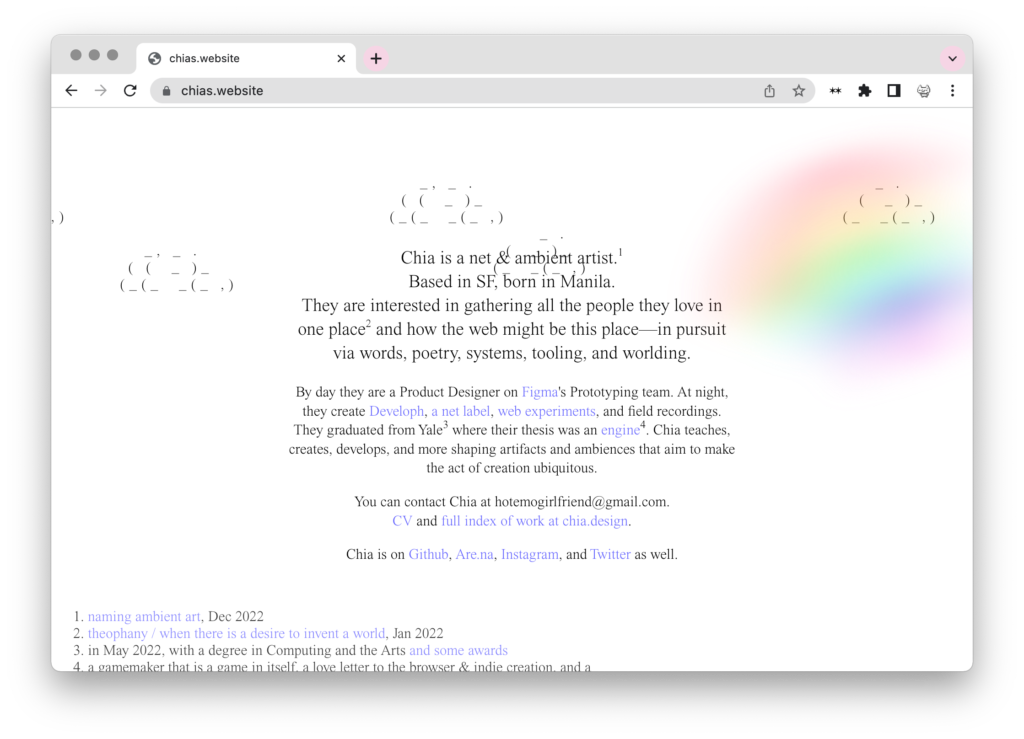( this blog post is being written in public. this block will be deleted when I decide it is ‘done’. pasting in research and figuring out thoughts live here )
Lately I have been looking up more. If I am interested in gathering, a poetry of tools, and ambience—perhaps I am also interested in clouds.

For their persistence and being all-enveloping, for the metaphor and infrastructure they represent. A simple take: In the interest of revealing/uplifting the invisible, we take ‘cloud storage’ for granted—using it as a throwaway term whenever we would like to offload the labor of computation and share how the world is faster, more efficient. This is also an issue of history and that of space. How the internet, networking, and computing takes form in our mind dominates our models about the online world we operate in. How did we once describe these structures and acts of labor before the cloud, and what comes after?
When we speak of clouds these days, it is as likely that we mean data clouds or network clouds as cumulus or stratus. In their sharing of the term, both kinds of clouds reveal an essential truth: that the natural world and the technological world are not so distinct.
John Durham Peters’s The Marvelous Clouds preview
What does it mean for poetics, too? Maybe my experience with the web is a poetry of clouds, hence the interest in the ambient, of stillness and ubiquity. We never describe the online world as poetic, yet so much of it is drawn from the organic world. Our life necessitates the online, yet compassion & love & patience & human acts seem detached amidst the focus on utility and over-optimization. When we think of poetry, we think of an art that cannot be detached from human identity in an age of new intelligences; but intelligences cannot replicate emotion or love or lived experience in the way we go forth. When I think of what moves me, I think of the emotional labor & connection & deep intertwine and understanding & all that is unspoken & I think about love that will never be cataloged or saved in bits. I think about the human act of labor, time, and intention that makes the most sincere and authentic forms of expression — and how the recognition of this, even outside the creation of love letters and art, in the infrastructural support of the world & where our memories are stored & who runs the servers even the slowest ones that we curse at that still let us live our lives — is a necessary act of acknowledgement alongside the guiding of us towards more folk, smaller, intentioned practices towards sincerity and creation on the web. Towards interdependence; one that is only possible once I can name what supports me.
A cloud, a computer, all a craft — in the way that we thatch roofs and secure spaces for one another.

Maybe there needs to be a radical re-thinking about our relationship to computers; a reconsideration of what or who we deem invisible. What are the environments that form around me and how do I see the vast expanse of what has brought me here today? What are the clouds above me and why do they roll that way?
These classes and books have been interesting to read through:
- https://lovelanguages.melaniehoff.com/
- https://github.com/mkgold/clouds/blob/master/cloud-syllabus.md
- https://press.uchicago.edu/ucp/books/book/chicago/M/bo20069392.html
- https://mitpress.mit.edu/9780262529969/a-prehistory-of-the-cloud/
- https://jntry.work/cloud/
- Computational Cultures after the Cloud
- https://spheres-journal.org/contribution/scaffolding-hard-and-soft-infrastructures-as-critical-and-generative-structures/
- https://www.continentcontinent.cc/index.php/continent/article/view/205